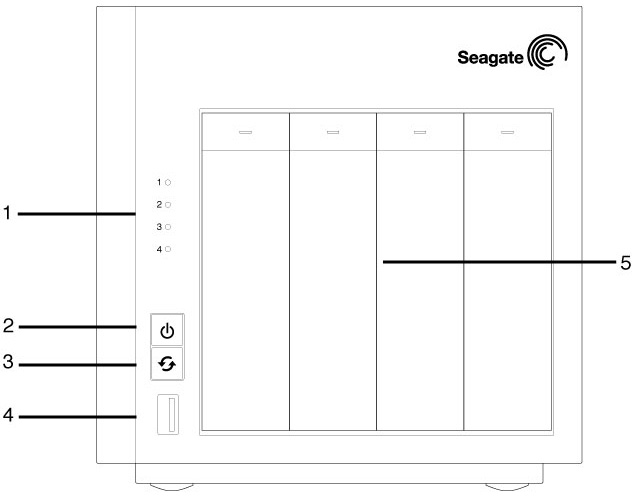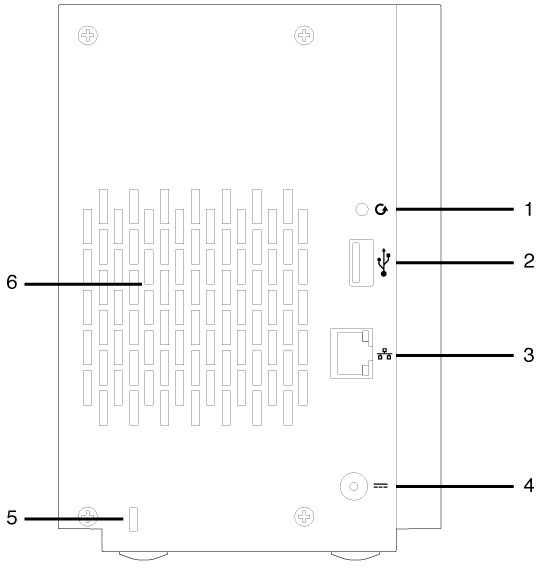Was this content helpful?
How could we make this article more helpful?
System Overview
The Seagate NAS is a hard drive enclosure available in two models.
- Seagate NAS 2Bay (up to two 3.5 inch/2.5 inch hard drives)
- Seagate NAS 4Bay (up to four 3.5 inch/2.5 inch hard drives)
Each individual hard drive is swappable and field replaceable. When installing hard drives into the Seagate NAS, make certain they are 3.0 Gb/s SATA that spin up to 7200 RPM. Seagate recommends NAS HDD.
Note: Your Seagate NAS is shipped with screws to mount 2.5-inch hard drives to the hard drive trays.
Specifications
Storage management
The Seagate NAS runs on Seagate NAS OS. Use the NAS OS administration tool to create volumes, shares, users, groups, and much more. See Software.
Enclosure dimensions
NAS 2Bay


NAS 4Bay


Enclosure weight
Weights can vary by disk manufacturer. The weights listed below are based upon Seagate NAS HDD.
NAS 2Bay
| Disks | Disk capacity | Weight (Kg / lbs) |
|---|---|---|
| 0 | N/A | 1.75 / 3.86 |
| 2 | 2TB | 2.81 / 6.19 |
| 2 | 4TB | 2.82 / 6.22 |
| 2 | 5TB | 2.83 / 6.24 |
NAS 4Bay
| Disks | Disk capacity | Weight (Kg / lbs) |
|---|---|---|
| 0 | N/A | 2.45 / 5.40 |
| 2 | 2TB | 3.51 / 7.74 |
| 2 | 4TB | 3.52 / 7.76 |
| 2 | 5TB | 3.53 / 7.78 |
| 4 | 2TB | 4.57 / 10.08 |
| 4 | 4TB | 4.59 / 10.12 |
| 4 | 5TB | 4.61 / 10.16 |
Temperature ranges
| Ambient environment | Temperature range |
|---|---|
| Standard (operating) | +0ºC to +40ºC |
| Storage (non-operating) | -20ºC to +60ºC |
Humidity
| Environment | Humidity range |
|---|---|
| Standard (operating) | 0% to 90% non-condensing |
| Storage (non-operating) | 0% to 95% non-condensing |
Electrical
The included power supply is meant for use with your specific Seagate NAS. It is not compatible with power supplies provided with other hard drive enclosures produced by Seagate, an affiliate of Seagate, or a third party.
NAS 2Bay
External power supply: 100 - 240 VAC, 50 / 60 Hz, 12 V / 48 W
NAS 4Bay
External power supply: 100 - 240 VAC, 50 / 60 Hz, 19 V / 90 W
Acoustics
NAS 2Bay
Operational: 20-32 dBA @ 1m
NAS 4Bay
Operational: 22-32 dBA @ 1
Front panel view
NAS 2Bay

- Hard drive LEDS: The LEDs blink to indicate activity for the drive.
- Power button and status LED: Turn the NAS on and off (see Operation). A LED will turn on once the button is pushed.
- One-touch backup button: Push the button to initiate a backup. The one-touch button must be configured using the NAS OS Backup Manager.
- SuperSpeed USB 3.0 Port: Connect a compatible USB storage device to the port.
- Hard drive bays: Bays for the hard drives.
For details on LED behavior, see System LEDs.
NAS 4Bay

- Hard drive LEDS: The LEDs blink to indicate activity for the drive.
- Power button and status LED: Turn the NAS on and off (see Operation). A LED will turn on once the button is pushed.
- One-touch backup button: Push the button to initiate a backup. The one-touch button must be configured using the NAS OS Backup Manager.
- SuperSpeed USB 3.0 Port: Connect a compatible USB storage device to the port.
- Hard drive bays: Bays for the hard drives.
For details on LED behavior, System LEDs .
Rear panel view
NAS 2Bay

- Recovery button: The recovery button is used to perform a NAS OS Rescue (see NAS OS Rescue). Use a pointed instrument to gently push the button within the cavity.
- SuperSpeed USB 3.0 port: Connect a compatible USB storage device to the port.
- Gigabit Ethernet ports:Connect the Ethernet cable from the device to your network. See Setup.
- Power input: Plug in the AC adapter supplied with the NAS. See Setup.
- Kensington lock: Secure the NAS to a desk using a compatible cable.
- Ventilation:Keeps your NAS's power supply unit cool during operation. Be sure not to block the fan exhaust when using the product.
NAS 4Bay

- Recovery button: The recovery button is used to perform a NAS OS Rescue (see NAS OS Rescue). Use a pointed instrument to gently push the button within the cavity.
- SuperSpeed USB 3.0 port: Connect a compatible USB storage device to the port.
- Gigabit Ethernet ports (x2): Connect the Ethernet cable from the device to your network. See Setup.
- Power input: Plug in the AC adapter supplied with the NAS. See Setup.
- Kensington lock: Secure the NAS to a desk using a compatible cable.
- Ventilation:Keeps your NAS's power supply unit cool during operation. Be sure not to block the fan exhaust when using the product.
USB 3.0 ports
The Seagate NAS has two USB 3.0 ports on the front and back of the device. Connect USB direct-attached storage (DAS) devices to the Seagate NAS for backups. Compatible file formats for DAS include: FAT32, NTFS, HFS+, EXT3, EXT4, and XFS. Other storage formats will not be recognized by the NAS. Capacity limitations do not apply.
Your Seagate NAS has a one-touch backup button on its front. Run the NAS OS Backup Manager to configure the one-touch button for automated backups to a compatible DAS.